Article categories:
Select a category below to view articles on each subject.
Search
Enter your keyword/s below to search :

Fish delivered straight to your door from Wildwoods
Hundreds of Species available today…
TFF Mailing List
Join the TFF mailing list today and we will email you with latest offers, news items and more.
-
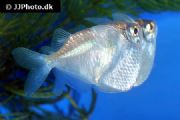
Species: Thoracocharax securis
-
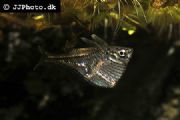
Species: Carnegiella marthae
-
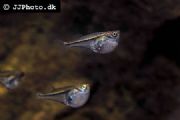
Species: Carnegiella myersi
-

Species: Carnegiella strigata
-
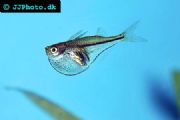
Species: Gasteropelecus levis
-
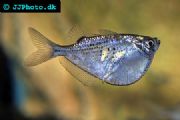
Species: Gasteropelecus myersi
-
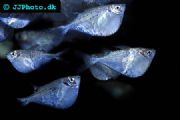
Species: Gasteropelecus maculatus
-
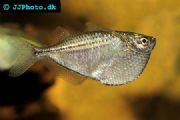
Species: Gasteropelecus sternicla
-
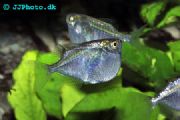
Species: Thoracocharax stellatus
-
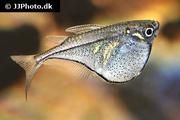
Species: Carnegiella scherei
A Review of Hatchetfish
Hatchetfish are a popular group of characins widely available in the aquatic industry. They are known for their unusual body shape with a large muscular convex ventral area as well as their ability to ‘fly’ out of the water using these powerful muscles (which account for a quarter of their total body weight) along with their pectoral fins to lift themselves out of the water. Many species have attractive markings along their body and a large group of these fish can be particularly stunning in the aquarium.
Taxonomy and Distribution
Freshwater hatchetfishes are members of the family Gasteropelecidae and make up the three genera Carnegiella, Gasteropelecus and Thoracocharax. There is a total of nine species of hatchetfish which originate from South America, but are notably absent from Chile.
General Care
Hatchetfish are often not seen at their best in the aquarium, as people tend to keep them in groups that are too small. These fish need the security of a larger group and so it is recommended that they are kept in groups of at least 8, but preferably more. They make good choices for the community tank as they are peaceful, but can be fairly shy and may be bullied by more boisterous species. Peaceful mid-water dwelling fish such as tetras and benthic fish such as Corydoras make good tank mates. The aquarium should be dimly lit and furnished with a darker substrate and floating plants to make these fish feel secure whilst a gentle current for these fish to swim against is also appreciated. The water should be soft, have a pH between 5.0-7.0 and a temperature between 24C and 27C. These fish will readily feed on live insects such as fruit flies (taking care not to feed wild insects) but will also eat a variety of frozen foods such as bloodworm and daphnia.
Carnegiella marthae Blackwing Hatchetfish
Carnegiella marthae, or the Blackwing Hatchetfish is one of the smaller species of Hatchetfish reaching just 2.8cm in length. It is endemic to the Rio Negro and Orinoco river basins. It should be housed in an aquarium at least 60cm in length with other small, peaceful fish that won’t outcompete it for food. Ideally it should be in groups bigger than six. This species can be somewhat delicate and will not tolerate rapid changes in water quality. Feed a diet of live and frozen foods such as fruit flies and non-wild ants along with bloodworm and daphnia.
Carnegiella strigata Marbled Hatchetfish
The Marbled Hatchetfish Carnegiella strigata is one of the more commonly species in the aquatic trade. Endemic to Colombia, Guyana, Brazil, Peru and Suriname, its body is covered in dark bands to give it a marbled effect and it is capable of reaching around 4cm in length. This species is not commonly bred in the aquatic industry and can be initially quite delicate after being imported, but once acclimatised it makes an excellent choice for the aquarium. This species will initially be reluctant to take dried foods but will learn to take them over time, although live or frozen foods should constitute most of its diet.
Carnegiella myersi Pygmy Hatchetfish
The Pygmy Hatchetfish Carnegiella myersi is endemic to the Peruvian Amazon Basin and is the smallest species of Hatchetfish reaching just 2.5cm when fully grown. Provide an aquarium 50cm in length for this species and house it with other small peaceful species. Pay particular attention to water quality as this species is highly sensitive and is one of the more delicate hatchetfish; it won't tolerate rapid swings in any water quality factors. Feed small live and frozen insects such as fruit flies and bloodworm along with floating dried feeds which it will lean to take.
Carnegiella schereri Dwarf Hatchetfish
The Dwarf Hatchetfish Carnegiella schereri is found throughout the Peruvian and Brazilian Amazon River Basin. It reaches just 2.6cm in length and should be housed in an aquarium around 60cm in length. Although not as delicate as some species, it will still only tolerate small changes in water quality and is still capable of being outcompeted for food. Keep in groups of six at the very least along with other small peaceful species such as tetras. Feed a diet consisting mainly of live and frozen insects such as ants, bloodworm and daphnia.
Thoracocharax stellatus Spotfin Hatchetfish
The Spotfin Hatchetfish Thorococharax stellatus is found under dense surface vegetation in forest streams throughout South America. It will typically reach a length of 8cm in the aquarium and so a tank at least 120cm in length is required to house a sufficiently big enough group of this species. Although this species is very peaceful, it is easily outcompeted by more boisterous species for food and as such should be kept with more peaceful fish inhabiting other areas of the tank such as tetras and bottom dwelling species such as Corydoras or Loricariids. Feed this species on a variety of frozen or live foods such as bloodworm or gut loaded fruit flies. In time it will also learn to accept dried foods.
Thoracocharax securis Giant Hatchetfish
The Giant Hatchetfish Thoracocharax securis, found throughout the Amazon Basin, is so called because of its relatively large adult length of 9cm. This species should be housed in aquaria at least 120cm in length in groups of five or more along with good aeration. It will do well in a community setup provided it is kept with other peaceful species. This species will relish live food and can be fed on food such as bloodworm, brine shrimp, glass worms, fruit flies and will also accept floating dried foods.
Gasteropelecus sternicla Common Hatchetfish
The Common Hatchetfish Gasteropelecus sternicla is typically found in slow moving streams and swamps throughout French Guiana, Venezuela, Guyana and Peru. It will usually reach around 6.5cm and requires a tank no smaller than 60cm in length. Like most Hatchetfish, it will not compete with more aggressive or boisterous species for food as it can be quite nervous and as such should only be kept with other peaceful species that inhabit different levels of the water column. The breeding method of this species is unknown so specimens within the trade are imported and can be fairly delicate until acclimatised. The diet should consist of live feeds of gut loaded insects such as fruit flies if they are available or a variety of frozen foods such as bloodworm.
Gasteropelecus levis Silver Hatchetfish
The Silver Hatchetfish Gasteropelecus levis is known to only be present in the Brazilian Amazon. It is one of the smaller species of Hatchetfish reaching just 3.5cm when fully grown and requiring a tank at least 60cm in length. This species is well suited to a community tank, but should not be housed with aggressive or more boisterous species as it will not be able to compete with them for food due to its somewhat nervous disposition. It has not been bred in captivity and as such specimens for sale are wild caught. Initially when imported this species can be somewhat delicate but is much better suited to captivity once acclimatised. It is often easily confused with G. sternicla which is usually the species offered for sale as Silver Hatchetfish. This species should be fed a diet of live and frozen foods such as bloodworm and daphnia and overtime will learn to eat dried foods.
Gasteropelecus maculatus Spotted Hatchetfish
The Spotted Hatchetfish Gasteropelecus maculatus originates from the lower Amazon Basin in Brazil. It usually reaches around 5cm in the aquarium, although specimens of over 6cm have been recorded. Provide an aquarium around 80cm in length and keep in groups of at least six. This species is peaceful and will do well in a community aquarium provided there are no aggressive or boisterous that are likely to outcompete this timid species for food. Feed a variety of frozen and live foods such as ants, bloodworm and fruit flies along with dried flake foods.
Other fish articles:
Other fish articles you may be interested in are listed below, click an article for full details.
-
FISH ARTICLE
-
FISH ARTICLE
-
FISH ARTICLE
-
FISH ARTICLE






